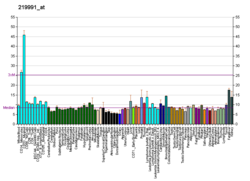From Wikipedia, the free encyclopedia
Protein-coding gene in the species Homo sapiens
Solute carrier family 2, facilitated glucose transporter member 9 is a protein that in humans is encoded by the SLC2A9 gene .[ 5] [ 6] [ 7]
This gene encodes a member of the SLC2A facilitative glucose transporter family. Members of this family play a significant role in maintaining glucose homeostasis. The encoded protein may play a role in the development and survival of chondrocytes in cartilage matrices. Two transcript variants encoding distinct isoforms have been identified for this gene.[ 7]
SLC2A9 has also recently been found to transport uric acid , and genetic variants of the transporter have been linked to increased risk of development of both hyperuricemia , gout and Alzheimer's disease .[ 8] [ 9] [ 10]
^ a b c GRCh38: Ensembl release 89: ENSG00000109667 – Ensembl , May 2017^ a b c GRCm38: Ensembl release 89: ENSMUSG00000005107 – Ensembl , May 2017^ "Human PubMed Reference:" . National Center for Biotechnology Information, U.S. National Library of Medicine .^ "Mouse PubMed Reference:" . National Center for Biotechnology Information, U.S. National Library of Medicine .^ Phay JE, Hussain HB, Moley JF (Aug 2000). "Cloning and expression analysis of a novel member of the facilitative glucose transporter family, SLC2A9 (GLUT9)". Genomics . 66 (2): 217–20. doi :10.1006/geno.2000.6195 . PMID 10860667 . ^ Manolescu AR, Augustin R, Moley K, Cheeseman C (Aug 2007). "A highly conserved hydrophobic motif in the exofacial vestibule of fructose transporting SLC2A proteins acts as a critical determinant of their substrate selectivity" . Mol Membr Biol . 24 (5–6): 455–63. doi :10.1080/09687680701298143 PMID 17710649 . S2CID 35331716 . ^ a b "SLC2A9 solute carrier family 2 member 9 [ Homo sapiens (human) ]" .^ Vitart V, Rudan I, Hayward C, et al. (2008). "SLC2A9 is a newly identified urate transporter influencing serum urate concentration, urate excretion and gout". Nature Genetics . 40 (4): 437–42. doi :10.1038/ng.106 . PMID 18327257 . S2CID 6720464 . ^ Döring A, Gieger C, Mehta D, et al. (2008). "SLC2A9 influences uric acid concentrations with pronounced sex-specific effects". Nature Genetics . 40 (4): 430–6. doi :10.1038/ng.107 . PMID 18327256 . S2CID 29751482 . ^ Hollingworth P, Sweet R, Sims R, et al. (2012). "Genome-wide association study of Alzheimer's disease with psychotic symptoms" . Molecular Psychiatry . 17 (12): 1316–1327. doi :10.1038/mp.2011.125 . PMC 3272435 PMID 22005930 .
Doege H, Bocianski A, Joost HG, Schürmann A (2001). "Activity and genomic organization of human glucose transporter 9 (GLUT9), a novel member of the family of sugar-transport facilitators predominantly expressed in brain and leucocytes" . Biochem. J . 350. Pt 3 (3): 771–6. doi :10.1042/0264-6021:3500771 . PMC 1221309 PMID 10970791 . Shikhman AR, Brinson DC, Valbracht J, Lotz MK (2001). "Cytokine regulation of facilitated glucose transport in human articular chondrocytes" . J. Immunol . 167 (12): 7001–8. doi :10.4049/jimmunol.167.12.7001 PMID 11739520 . Mobasheri A, Neama G, Bell S, et al. (2002). "Human articular chondrocytes express three facilitative glucose transporter isoforms: GLUT1, GLUT3 and GLUT9". Cell Biol. Int . 26 (3): 297–300. doi :10.1006/cbir.2001.0850 . PMID 11991658 . S2CID 34492031 . Strausberg RL, Feingold EA, Grouse LH, et al. (2003). "Generation and initial analysis of more than 15,000 full-length human and mouse cDNA sequences" . Proc. Natl. Acad. Sci. U.S.A . 99 (26): 16899–903. Bibcode :2002PNAS...9916899M . doi :10.1073/pnas.242603899 PMC 139241 PMID 12477932 . Richardson S, Neama G, Phillips T, et al. (2003). "Molecular characterization and partial cDNA cloning of facilitative glucose transporters expressed in human articular chondrocytes; stimulation of 2-deoxyglucose uptake by IGF-I and elevated MMP-2 secretion by glucose deprivation" . Osteoarthr. Cartil . 11 (2): 92–101. doi :10.1053/joca.2002.0858 PMID 12554125 . Ota T, Suzuki Y, Nishikawa T, et al. (2004). "Complete sequencing and characterization of 21,243 full-length human cDNAs" . Nat. Genet . 36 (1): 40–5. doi :10.1038/ng1285 PMID 14702039 . Augustin R, Carayannopoulos MO, Dowd LO, et al. (2004). "Identification and characterization of human glucose transporter-like protein-9 (GLUT9): alternative splicing alters trafficking" . J. Biol. Chem . 279 (16): 16229–36. doi :10.1074/jbc.M312226200 PMID 14739288 . Gerhard DS, Wagner L, Feingold EA, et al. (2004). "The status, quality, and expansion of the NIH full-length cDNA project: the Mammalian Gene Collection (MGC)" . Genome Res . 14 (10B): 2121–7. doi :10.1101/gr.2596504 . PMC 528928 PMID 15489334 .
This article incorporates text from the United States National Library of Medicine , which is in the public domain .
By group
SLC1–10
(1): (2): (3): (4): (5): (6): (7): (8): (9): (10):
SLC11–20
(11): (12): (13): (14): (15): (16): (17): (18): (19): (20):
SLC21–30
(21): (22): (23): (24): (25): (26): (27): (28): (29): (30):
SLC31–40
(31): (32): (33): (34): (35): (36): (37): (38): (39): (40):
SLC41–48
(41): (42): (43): (44): (45): (46): (47): (48):





